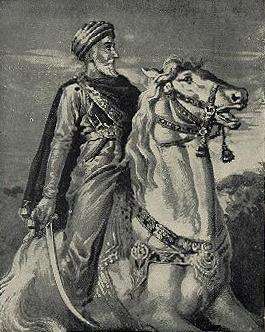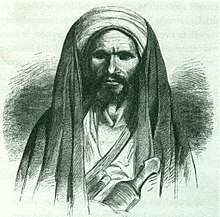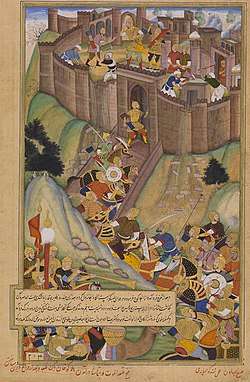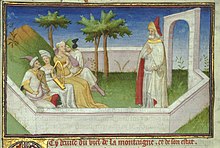Hassan-i Sabbah
Hassan-i Sabbāh (Persian: حسن صباح, romanized: Hasan-i Sabbāh) or Hassan as-Sabbāh (Arabic: حسن الصباح, romanized: Ḥasan al-Ṣabbāḥ, full name: Hasan bin Ali bin Muhammad bin Ja'far bin al-Husayn bin Muhammad bin al-Sabbah al-Himyari;[1] c. 1050 – 12 June 1124)[2][3] was the founder of the Nizari Isma'ili state and its fidā'i military group[4] known as Order of Assassins.[5] (often referred also as the Hashshashin).
Hassan-i Sabbah | |
|---|---|
 | |
| Title | Mawla of Alamut |
| Personal | |
| Born | c. 1050 |
| Died | 12 June 1124 (aged 73–74) Alamut Castle, Nizari Ismaili State, Iran |
| Religion | Shia Islam |
| Jurisprudence | Nizārī, Da'a'im al-Islam |
| Main interest(s) | |
| Occupation | Leader of Nizārī Ismā'īlī state |
| Senior posting | |
Influenced
| |
Hassan-i Sabbāh was a missionary who converted the people of the Alborz Mountains of northern Iran to Nizari Isma'ilism in the late 11th century. He later seized a mountain fortress called Alamut.[6]
Sources
Hassan is thought to have written an autobiography, which did not survive but seems to underlie the first part of an anonymous Isma'ili biography entitled Sargozasht-e Seyyednā (Persian: سرگذشت سیدنا). The latter is known only from quotations made by later Persian authors.[7] Hassan also wrote a treatise, in Persian, on the doctrine of ta'līm, called, al-Fusul al-arba'a[8] The text is no longer in existence, but fragments are cited or paraphrased by al-Shahrastānī and several Persian historians.[8]
Early life and conversion
Qom and Rayy

The possibly autobiographical information found in Sargozasht-i Seyyednā is the main source for Hassan's background and early life. According to this, Hassan-i Sabbāh was born in the city of Qom (Iran) in the 1050s to a family of Twelver Shī‘ah.[7] His father, a Kufan Arab reportedly of Yemenite origins, had left the Sawād of Kufa (modern Iraq) to settle in the town of Qom[9][1], one of the first centres of Arab settlement in Persia and a stronghold of Twelver Shi`ism[10].
Early in his life, his family moved to Rayy.[7] Rayy was a city that had a history of radical Islamic thought since the 9th century, with Hamdan Qarmaṭ as one of its teachers.
It was in this religious centre that Hassan developed a keen interest in metaphysical matters and adhered to the Twelver code of instruction. During the day[11] he studied at home, and mastered palmistry, languages, philosophy, astronomy and mathematics (especially geometry).[12]
Rayy was also the home of Ismā‘īlī missionaries in the Jibal. At the time, Isma'ilism was a growing movement in Persia and other lands east of Egypt.[13] The Persian Isma'ilis supported the da'wa ("mission") directed by the Fatimid caliphate of Cairo and recognized the authority of the Imam-Caliph al-Mustanṣir (d. 1094), though Isfahan, rather than Cairo, may have functioned as their principal headquarters.[13] The Ismā'īlī mission worked on three layers: the lowest was the fida'i or foot soldier, followed by the rafīk or comrade, and finally the dā‘ī or missionary. It has been suggested that the popularity of the Ismā'īlī religion in Persia was due to the people's dissatisfaction with the Seljuk rulers, who had recently removed local rulers.[7]
In Rayy, a young Hassan came in touch with Amira Darrab, a comrade, who introduced him to the Ismā'īlī doctrine. Although Hassan was initially unimpressed, his interest gradually grew after he participated in many passionate debates that discussed the merits of Ismā‘īl over Mūsā. Seeing the conviction of Darrab convinced Hassan to delve deeper into Ismā'īlī doctrines and beliefs, ultimately convincing him to see merit in switching to the Ismā‘īlī faith.
Conversion to Ismailism and training in Cairo
At the age of 17, Hassan converted and swore allegiance to the Fatimid caliph in Cairo. Hassan's studies did not end with his crossing over. He further studied under two other dā‘iyyayn, and as he proceeded on his path, he was looked upon with eyes of respect.[4]
Hassan's austere and devoted commitment to the da'wa brought him in audience with the chief missionary of the region: 'Abdu l-Malik ibn Attash. Ibn Attash, suitably impressed with the young seventeen-year-old Hassan, made him Deputy Missionary and advised him to go to Cairo to further his studies.
However, Hassan did not go to Cairo. Some historians have postulated that Hassan, following his conversion, was playing host to some members of the Fatimid caliphate, and this was leaked to the anti-Fatimid and anti-Shī‘a vizier Nizam al-Mulk. This prompted his abandoning Rayy and heading to Cairo in 1076.
Hassan took about 2 years to reach Cairo. Along the way he toured many other regions that did not fall in the general direction of Egypt. Isfahan was the first city that he visited. He was hosted by one of the Missionaries of his youth, a man who had taught the youthful Hassan in Rayy. His name was Resi Abufasl and he further instructed Hassan.
From here he went to Caucasian Albania (current Azerbaijan), hundreds of miles to the north, and from there through Armenia. Here he attracted the ire of priests following a heated discussion, and Hassan was thrown out of the town he was in.
He then turned south and traveled through Iraq, reached Damascus in Syria. He left for Egypt from Palestine. Records exist, some in the fragmentary remains of his autobiography, and from another biography written by Rashid-al-Din Hamadani in 1310, to date his arrival in Egypt at 30 August 1078.
It is unclear how long Hassan stayed in Egypt: about 3 years is the usually accepted amount of time. He continued his studies here, and became a full missionary.
Return to Persia
Whilst he was in Cairo, studying and preaching, he incurred the displeasure of the Chief of the Army, Badr al-Jamalī.[14] This may have been a result of the fact that Hassan supported Nizar, the Ismaili Imam-Caliph al-Mustanṣir's elder son, as the next Imam. Hassan was briefly imprisoned by Badr al-Jamali. The collapse of a minaret of the jail was taken to be an omen in favor of Hassan and he was promptly released and deported. The ship that he was traveling on was wrecked. He was rescued and taken to Syria. Traveling via Aleppo and Baghdad, he terminated his journey at Isfahan in 1081.
Hassan's life now was totally devoted to the mission. Hassan toured extensively throughout Persia. In northern Persia, touching the south shore of the Caspian Sea, are the mountains of Alborz. These mountains were home to a people who had traditionally resisted attempts by both Arabs and Turkish subjugation; this place was also a home of Shī‘a leaning. The news of this Ismā'īlī's activities reached Nizam al-Mulk, who dispatched his soldiers with the orders for Hassan's capture. Hassan evaded them, and went deeper into the mountains.
Capture of Alamut

His search for a base from which to guide his mission ended when in 1088 he found the castle of Alamut in the Rudbar area (modern Qazvin, Iran). It was a fort that stood guard over a valley that was about fifty kilometers long and five kilometers wide. This fortress had been built about the year 865; legend has it that it was built by a king who saw his eagle fly up to and perch upon a rock, a propitious omen, the importance of which this king, Wah Sudan ibn Marzuban, understood. Likening the perching of the eagle to a lesson given by it, he called the fort Aluh Amu(kh)t: the "Eagles' Teaching".[15]
Hassan's takeover of the fort was conducted without any significant bloodshed. To effect this transition Hassan employed a patient and deliberate strategy, one which took the better part of two years to effect. First Hassan sent his Daʻiyyīn and Rafīks to win over the villages in the valley, and their inhabitants. Next, key people amongst this populace were converted, and finally, in 1090, Hassan took over the fort by infiltrating it with his converts.[16] Hassan gave the former owner a draft drawn on the name of a wealthy landlord and told him to obtain the promised money from this man; when the landlord saw the draft with Hassan's signature, he immediately paid the amount to the fort's owner, astonishing him. Another, probably apocryphal version of the takeover states that Hassan offered 3000 gold dinars to the fort's owner for the amount of land that would fit a buffalo's hide. The terms having been agreed upon, Hassan cut the hide into strips and linked them into a large ring around the perimeter of the fort, whose owner was thus undone by his own greed.
While legend holds that after capturing Alamut Hassan thereafter devoted himself so faithfully to study, that in the nearly 35 years he was there he never left his quarters, excepting only two times when he went up to the roof. This reported isolation is highly doubtful, given his extensive recruiting and organizational involvement in the growing Ismā'īlī insurrections in Persia and Syria.[17] Nonetheless, Hassan was highly educated and was known for austerity, studying, translating, praying, fasting, and directing the activities of the Daʻwa: the propagation of the Nizarī doctrine was headquartered at Alamut. He knew the Qur'ān by heart, could quote extensively from the texts of most Muslim sects, and apart from philosophy, was well versed in mathematics, astronomy, alchemy, medicine, architecture, and the major scientific disciplines of his time.[18] In a major departure from tradition, Hassan declared Persian to be the language of holy literature for Nizaris, a decision that resulted in all the Nizari Ismā'īlī literature from Persia, Syria, Afghanistan and Central Asia to be transcribed in Persian for several centuries.[15]
Old Man of the Mountain

Hassan, the founder of Nizari Isma'ilis in Persia, was designated by Marco Polo using a Syrian equivalent term known in Europe at that time,[19] as Elder or Old Man of the Mountain. Polo's travelogue (ca. 1300) describes Hassan as a charlatan who devised plots to convert young men to his sect. At the court of the Old Man of the Mountain "they were educated in various languages and customs, courtly etiquette, and trained in martial and other skills".[20] At Alamut they had "impressive libraries whose collections included books on various religious traditions, philosophical and scientific texts, and scientific equipment".[21]
Xishiji, a Chinese manuscript completed in 1263, relates a story similar to that of Polo. The sect leaders "ordered to send assassins to hide in those kingdoms which did not surrender. They stabbed their lords, and women as well, and they died".[22] A Nizari assassin is identified as fida'i or devotee, "who offers his life for others or in the service of a particular cause".[23]
Nizari doctrine
Historians and scholars identify Hassan-i Sabbah as the founder of the Nizari Assassins and their doctrine. It developed during the struggle for succession of Nizar to the Fatimid throne in Cairo that eventually laid the foundation of the Nizari Isma'ilism Shia Islam.[24] Since then, as a basic element of conservative nature, the Ismaili Imamate includes a hidden imam, in addition to the visible (or hazar, meaning apparent)[25] imam of the time, acting as such in a community. An important task of the latter is the proliferation of the doctrine, and of the undisclosed imam's spiritual guidance, in learning centers having instructors proficient in teaching techniques.[26]
Devotion of the "true believers" having "absolute faith"[27] in the beliefs is another element originating from the times of Sabbah in Northern Iran,[28] who "was so devout that he even had one of his sons executed after he was accused of drunkenness".[29]
Personal life
Hasan is known for his ascetic and austere religious lifestyle. He reportedly left his living quarters in the Alamut Castle only twice to ascend the rooftop.[30]
Hassan-i Sabbah probably had one wife, two daughters, and two sons.[31][32] Both of his sons were executed by Hasan's order; one for drinking wine, and another for being suspected of involving in the murder of da'i Husayn Qa'ini. Hasan's wife and daughters had been sent to Gerdkuh as a safe place during Shirgir's campaign against Alamut; they never returned. They lived on spinning.[33]
Representation in music and popular culture
- A song on Hawkwind's 1977 album Quark, Strangeness and Charm is titled Hassan I Sabbah.
- A 1938 novel named Alamut by Vladimir Bartol is based on Hassan's rise to power.[34][35]
- Hassan-i Sabbāh is mentioned, often by his moniker 'The Old Man of the Mountain', in many of William S. Burroughs's novels, including Nova Express, Cities of the Red Night,[36] The Place of Dead Roads and The Western Lands.[37][38][39][40]
- Hassan is also mentioned in the accompanying story to The Rock of Alamut, a 1000 piece jigsaw puzzle by Nadirshah Mackwani.[41]
- There are various Assassin class Servants who go by the name of "Hassan-i Sabbah" in the Fate/stay night anime and visual novel franchise, most notably in Fate/Zero, and the Heaven's Feel Route of Fate/stay night, where they appear as antagonists. However they appear as allied protagonists in the mobile game Fate/Grand Order, particularly during the Camelot chapter. Hassan himself, identified as the "First Hassan", is also present in the game. It is established that "Hassan-i Sabbah" is a title used by each of the nineteen leaders of the Hashshashin.
- The album In the Absence of Truth by ISIS draws inspiration from Hassan-i Sabbah.
- Hassan-i Sabbāh is one of the characters in Amin Maalouf's novel Samarkand.
- Attributed in Phil Hine's book Condensed Chaos and in the chaos magic scene with the quote, "Nothing is true, everything is permitted."[42]
See also
Notes
- Daftary, Farhad (September 2007). "Nizari Isma'ili history during the Alamut period". The Ismā'īlīs: Their History and Doctrines. Cambridge University Press. p. 313. ISBN 978-0-521-61636-2.
His father, 'Ali b. Muhammad b. Ja'far b. al-Husayn b. Muhammad b. al-Sabbah al-Himyari, a Kufan Arab claiming Yamani origins, had migrated from the Sawad of Kufa to the traditionally Shi'i town of Qumm in Persia.
- Frischauer, Willi (1970). "Chapter II". The Aga Khans. The Bodley Head. p. 40. ISBN 0-370-01304-2.
- Daftary, Farhad; Ali-de-Unzaga, Omar. "Hasan Sabbah". The Institute of Ismaili Studies. Retrieved 5 February 2018.
- Lewis, Bernard (1967), The Assassins: a Radical Sect of Islam, pp 38-65, Oxford University Press
- Chisholm, Hugh (1911). "Ḥasan-e Ṣabbāḥ". Encyclopædia Britannica (11th ed.). Cambridge University Press.
- Daftary, Farhad (2012). Historical Dictionary of the Ismailis. Scarecrow Press. p. 15. ISBN 9780810861640.
- Daftary, Farhad, The Isma'ilis, p. 311.
- Farhad Daftary, Ismaili Literature: A Bibliography of Sources and Studies, (I.B.Tauris, 2004), 115.
- Lewis, Bernard (November 2002). "3. The New Preaching". The Assassins. Basic Books. p. 38. ISBN 978-0-465-00498-0.
Hasan-i Sabbah was born in the city of Qumm, one of the first centres of Arab settlement in Persia and a stronghold of Twelver Shi`ism., His father, a Twelver Shiite, had come from Kufa in Iraq, and was said to be of Yemeni origin - more fancifully, a descendant of the ancient Himyaritic kings of Southern Arabia.
- Lewis, Bernard (1967). The Assassins: A Radical Sect in Islam. Oxford University Press.
- Nizam al-Mulk Tusi, pg. 420, foot note No. 3
- E. G. Brown Literary History of Persia, Vol. 1, p. 201.
- Daftary, Farhad, The Isma'ilis, pp. 310–11.
- Daftary, Farhad (September 2007). "Nizari Isma'ili history during the Alamut period". The Ismā'īlīs: Their History and Doctrines 2nd Edition. Cambridge University Press. p. 313. ISBN 978-0-521-61636-2.
- Daftary, Farhad (September 2007). "Nizari Isma'ili history during the Alamut period". The Ismā'īlīs: Their History and Doctrines 2nd Edition. Cambridge University Press. p. 316. ISBN 978-0-521-61636-2.
- Daftary, Farhad (September 2007). "Nizari Isma'ili history during the Alamut period". The Ismā'īlīs: Their History and Doctrines 2nd Edition. Cambridge University Press. p. 317. ISBN 978-0-521-61636-2.
- Daftary, Farhad (September 2007). "Nizari Isma'ili history during the Alamut period". The Ismā'īlīs: Their History and Doctrines 2nd Edition. Cambridge University Press. pp. 318–324. ISBN 978-0-521-61636-2.
- "Hassan Sabbah Dabbled in Astronomy: Experts". Chnpress.com. Archived from the original on 17 October 2011. Retrieved 30 January 2012.
- Aziz, Abualy A. "A Brief History of Ismailism. Preface". amaana.org. Retrieved 8 January 2018.
- Wasserman, James (8 August 2017). "A Note to the Reader on the Historical Context". Templar Heresy: A Story of Gnostic Illumination. Destiny Books. ISBN 978-1-62055-658-0.
- "Episode Synopses". The Ismaili. Islamic Publications Limited. Retrieved 5 February 2018.
- "The Mountain without the Old Man: Xishiji on Ismailis. PROCEEDINGS OF THE 2ND INTERNATIONAL ISMAILI STUDIES CONFERENCE" (PDF). Carleton University, Canada. March 2017. Retrieved 8 January 2018.
- "Fedāʾī". Encyclopædia Iranica. Retrieved 8 January 2018.
- Campbell, Anthony (2008). "The Nizari schism – eleventh century". The Assassins of Alamut. Lulu.com. ISBN 978-1-4092-0863-1.
- Mumtaz, Ali Tajddin. "Hazar Imam". Ismaili Electronic Library and Database. Retrieved 9 March 2018.
- Mohammad, Miraly N. (2016). Faith and World: Contemporary Ismaili Social and Political Thought. iUniverse. ISBN 978-1-4917-8972-8.
- Webel, Charles P. (2004). "Depicting the Indescribable: A Brief History of Terrorism". Terror, Terrorism, and the Human Condition. Palgrave MacMillan. p. 25. ISBN 1-4039-6161-1.
- DTIC, US Army (2005). "Terror in Antiquity: First to Fourteenth Century A.D.". A Military Guide to Terrorism in the Twenty-First Century. U.S. Army DCSINT Handbook No. 1 (Version 3.0). Defense Technical Information Center.
- Crenshaw, Martha; Pimlott, John (1997). "The Assassins: a terror cult". International Encyclopedia of Terrorism. Fitzroy Dearborn. ISBN 1-57958-022-X.
- Daftary 2007, p. 343-344
- نسب, مسعود مطهری; سپاهی, مجتبی. "کاربرد رویکرد شناسی در مطالعات تمدن اسلامی". فصلنامه تاریخ فرهنگ و تمدن اسلامی (in Persian). 9 (30): 7–34. ISSN 2252-0538.
- Daftary 2007, p. 343-344
- Daftary 2007, p. 343-344
- Bassas, Carlos (29 December 2016). "Assassin's Creed". Diario de Navarra (in Spanish). Retrieved 5 February 2018.
- Rad, Chloi (27 December 2017). "11 videojuegos que no sabías que están basados en libros". IGN (in Spanish). Retrieved 5 February 2018.
- '"Nothing is true, everything is permitted." The last words of Hassan i Sabbah, the Old Man of the Mountain.' William S. Burroughs. Cities of the Red Night (New York: Henry Holt and Company, 2013 [1981]). p. 158
- Burroughs, William S. (1964). Kuhlman, Roy (ed.). Nova Express. Grove Press.
- Burroughs, William S. (1981). Cities of the Red Night. Viking Press. ISBN 0-312-27846-2. OCLC 46887518.
- Burroughs, William S. (1983). The Place of Dead Roads. Viking Press. pp. 306. ISBN 0-03-070416-2. OCLC 9489103.
- Burroughs, William S. The Western Lands. Viking, 1988.
- Simerg.com. "Alamut: A 1000 Piece Jigsaw Puzzle by Nadirshah Mackwani". Retrieved 20 February 2018.
- Hine, Phil (1995). "Fractal Logic". Condensed Chaos. The Original Falcon Press. p. 24. ISBN 978-1-935150-66-4.
References
- Firdous-a-iblees by anayat ullah
Secondary sources
- Daftary, Farhad, The Isma'ilis: Their History and Doctrines. 2nd ed (1990). Cambridge et al., 2007.
- Daftary, Farhad (2007). The Isma'ilis: Their History and Doctrines (2nd, revised ed.). Cambridge University Press. ISBN 978-1-139-46578-6.
- Irwin, Robert. "Islam and the Crusades, 1096–1699". In The Oxford History of the Crusades, ed. Jonathan Riley Smith. Oxford, 2002. 211–57.
Further reading
- Firdous-e-Iblees by Anayat Ullah
- Hasan-I-Sabbah: His Life and Thought by Dr. Ali Mohammad Rajput
Primary sources
- Hassan-i Sabbah, al-Fuṣūl al-arba'a ("The Four Chapters"), tr. Marshall G.S. Hodgson, in Ismaili Literature Anthology. A Shi'i Vision of Islam, ed. Hermann Landolt, Samira Sheikh and Kutub Kassam. London, 2008. pp. 149–52. Persian treatise on the doctrine of ta'līm. The text is no longer extant, but fragments are cited or paraphrased by al-Shahrastānī and several Persian historians.
- Sarguzasht-e Sayyidnā
- Nizam al-Mulk
- al-Ghazali
Secondary sources
- Daftary, Farhad, A Short History of the Ismā'īlīs. Edinburgh: Edinburgh University Press, 1998.
- Daftary, Farhad, The Assassin Legends: Myths of the Ismā'īlīs. London: I.B. Tauris & Co. Ltd, 1994. Reviewed by Babak Nahid at Ismaili.net
- Daftary, Farhad, "Hasan-i Sabbāh and the Origins of the Nizārī Ismā'īlī movement." In Mediaeval Ismā'īlī History and Thought, ed. Farhad Daftary. Cambridge: Cambridge University Press, 1996. 181–204.
- Hodgson, Marshall, The Order of Assassins. The Struggle of the Early Nizārī Ismā'īlī Against the Islamic World. The Hague: Mouton, 1955.
- Hodgson, Marshall, "The Ismā'īlī State." In The Cambridge History of Iran, vol. 5: The Saljuq and Mongol Periods, ed. J.A. Boyle. Cambridge: Cambridge University Press, 1968. 422–82.
- Lewis, Bernard, The Assassins. A Radical Sect in Islam. New York: Basic Books, 1968.
- Madelung, Wilferd, Religious Trends in Early Islamic Iran. Albany: Bibliotheca Persica, 1988. 101–5.
External links
- HASAN BIN SABBAH AND NIZARI ISMAILI STATE IN ALAMUT
- The life of Hassan-i-Sabah from an Ismaili point of view. Focuses on assassination as a tactic of asymmetrical warfare and has a small section on Hasan-i-Sabah's work as a scholar.
- Introduction to The Assassin Legends (From The Assassin Legends: Myths of the Isma‘ilis, London: I. B. Tauris, 1994; reprinted 2001.)
- The life of Hassan-i-Sabbah as part of an online book on the Assassins of Alamut.
- Arkon Daraul on Hassan-i-Sabbah.
- An illustrated article on the Order of Assassins.
- William S. Burrough's invocation of Hassan-i-Sabbah in Nova Express.
- Assassins entry in the Encyclopedia of the Orient.
- Review of the book, "The Assassin Legends: Myths of the Isma'ilis (I. B. Tauris & Co. Ltd: London, 1994), 213 pp." by Babak Nahid, Department of Comparative Literature, University of California, Los Angeles
- Ismaili Imams and their Love for Knowledge. Islamic Publications Limited
